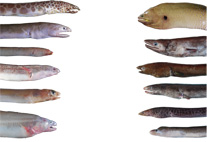Abstract
The following nine elongate unpatterned muraenid species of the subfamily Muraeninae, including one new species, are recognized from Taiwan and adjacent waters: Gymnothorax albimarginatus (Temminck & Schlegel), G. dorsalis Seale, G. melanosomatus Loh, Shao & Chen, G. phasmatodes (Smith), G. prolatus Sasaki & Amaoka, G. sagmacephalus Böhlke, Pseudechidna brummeri (Bleeker), Strophidon sathete (Hamilton) and G. pseudomelanosomatus new species, described from two specimens. This new moray eel is distinguished from its similar species, G. melanosomatus, by the following features: grey brown body (vs. black), snout length 20.5% (vs. 17.8%) of head length, smaller eye diameter 8.2% (vs. 10.0%) of head length; preanal length 49.5% (vs. 58.5%) total length, and preanal vertebrae 89–89 (vs. 105–109). Phylogenetic relationships of the nine species were examined using nucleotide sequence data from partial sequences of mitochondrial ND5 gene (600 bp), and seven species form COI (600 bp). The genetic analyses suggest that G. pseudomelanosomatus is distinct from G. melanosomatus and the other six species of Gymnothorax. Morphological features and mitogenetic affinities strongly suggest that “G.” dorsalis should be placed in Strophidon rather than in Gymnothorax. The results also suggest that employment of ND5 and COI gene sequences are rather useful for identification of species and for obtaining reasonable insights into the phylogeny of the muraenid species.

